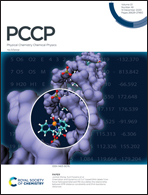Strengthening mechanism of Si, V and Ti atoms to the Ag/AlN interface: a study from first-principles calculations
Abstract
Active elements play key roles in improving the interfacial bonding between Ag-based fillers and AlN ceramics. An understanding of the influence mechanism of active elements to interfacial adhesion can help us optimize the composition of active filler metals. In this paper, Ag(111)/AlN(0001) interfaces with different terminations and stacking sequences were constructed first. The N-terminated A-site interface was found to have the largest work of adhesion (Wad). Then, the effects of Si, Ti and V dopants on the Ag/AlN interfacial bonding were investigated via first-principles calculations. The results reveal that the Ti and V dopants can increase the values of Wad significantly. Electronic structure analysis reveals that the Si–N, Ti–N and V–N bonds formed at the interface are mainly ionic, and with some composition of covalent. Ti and V atoms can form strong bonds with not only the AlN slab, but also the neighboring Ag layers. It can be concluded that Ag–Ti and Ag–V active fillers are more suited to braze AlN. Ti–N and V–N compounds formed at the interface can greatly improve the interfacial bonding strength.



 Please wait while we load your content...
Please wait while we load your content...